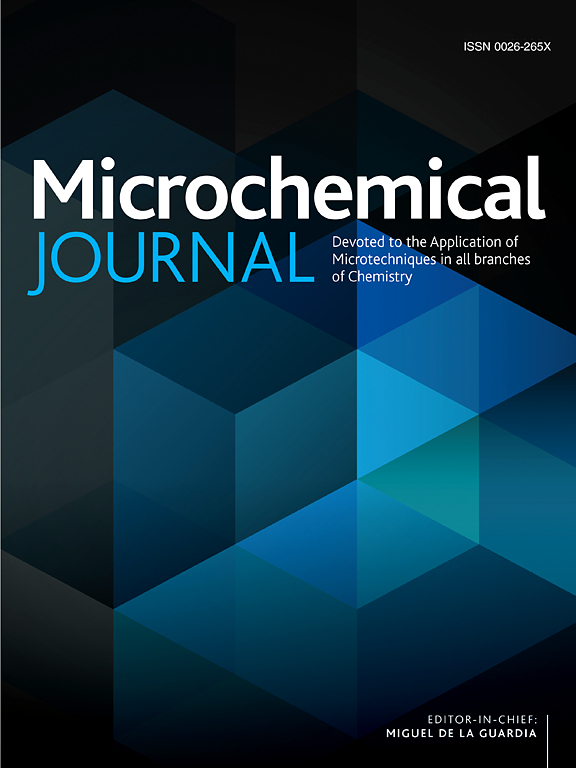一种快速测定食品中脱氢乙酸的ATPS-HPLC(GC)方法
IF 4.9
2区 化学
Q1 CHEMISTRY, ANALYTICAL
引用次数: 0
摘要
脱氢乙酸(DHA)是一种广泛应用于食品中的常用防腐剂。目前,DHA的定量分析过程仍然繁琐,涉及多种有毒有机试剂。为了解决这些问题,本研究利用水两相系统(ATPS)的低毒、环保和快速的特点,开发了一种适合提取和纯化DHA的预处理方法。该方法与高效液相色谱(HPLC)和气相色谱(GC)技术兼容。对于高效液相色谱,开发了酸性色谱条件,以减轻峰尾和保留时间漂移等问题,改善峰形状并稳定保留时间。气相色谱方面,建立了准确定量分析DHA的色谱条件。研究重点是筛选合适的ATPS类型,并优化其组成成分的组成比例,以达到最佳的DHA提取和纯化效率。对ATPS-HPLC法和ATPS-GC法进行了方法验证和样品分析。结果表明,在5.00 mL水、2.00 mL正丙醇、7.00 g磷酸二氢钠组成的ATPS条件下,该方法准确、可靠、快速、环保,检出限为2.00 × 10−4 g/kg (6.00 × 10−4 g/kg),平均加样回收率为93.7 ~ 104%(98.3 ~ 107%),相对标准偏差(rsd)为0.7 ~ 5.2%(1.9 ~ 6.8%)。本文章由计算机程序翻译,如有差异,请以英文原文为准。
A Novel ATPS-HPLC(GC) method for the rapid Quantification of dehydroacetic acid in food
Dehydroacetic acid (DHA) is a commonly used preservative widely applied in food products. Currently, the quantitative analysis process for DHA remains cumbersome, involving multiple toxic organic reagents. To address these issues, this study leveraged the low-toxicity, environmentally friendly, and rapid characteristics of aqueous two-phase systems (ATPS) to develop a pretreatment method suitable for the extraction and purification of DHA. This method is compatible with both high-performance liquid chromatography (HPLC) and gas chromatography (GC) techniques. For HPLC, acidic chromatographic conditions were developed to mitigate issues such as peak tailing and retention time drift, improving peak shapes and stabilizing retention times. For GC, appropriate chromatographic conditions were established for accurate quantitative analysis of DHA. The study focused on screening appropriate ATPS types and optimizing the composition ratios of their constituent components to achieve optimal extraction and purification efficiency for DHA. Method validation and sample analysis were conducted for both ATPS-HPLC and ATPS-GC approaches. Under the ATPS conditions composed of 5.00 mL water, 2.00 mL n-propanol, and 7.00 g sodium dihydrogen phosphate, results demonstrated that the ATPS-HPLC (GC) method is accurate, reliable, rapid, and environmentally friendly, with detection limits of 2.00 × 10−4 g/kg (6.00 × 10−4 g/kg), average recoveries of 93.7–104 % (98.3–107 %), and relative standard deviations (RSDs) of 0.7–5.2 % (1.9–6.8 %).
求助全文
通过发布文献求助,成功后即可免费获取论文全文。
去求助
来源期刊

Microchemical Journal
化学-分析化学
CiteScore
8.70
自引率
8.30%
发文量
1131
审稿时长
1.9 months
期刊介绍:
The Microchemical Journal is a peer reviewed journal devoted to all aspects and phases of analytical chemistry and chemical analysis. The Microchemical Journal publishes articles which are at the forefront of modern analytical chemistry and cover innovations in the techniques to the finest possible limits. This includes fundamental aspects, instrumentation, new developments, innovative and novel methods and applications including environmental and clinical field.
Traditional classical analytical methods such as spectrophotometry and titrimetry as well as established instrumentation methods such as flame and graphite furnace atomic absorption spectrometry, gas chromatography, and modified glassy or carbon electrode electrochemical methods will be considered, provided they show significant improvements and novelty compared to the established methods.
 求助内容:
求助内容: 应助结果提醒方式:
应助结果提醒方式:


